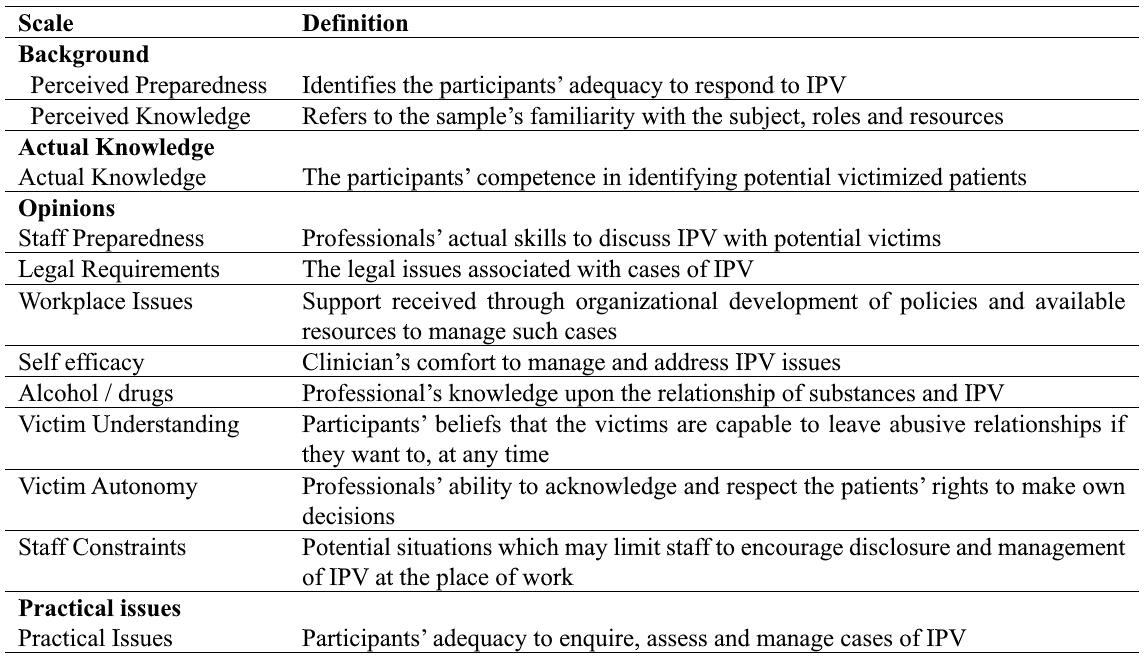Knowledge, Attitude, Preparedness and Behavior of Nurses Towards Intimate Partner Violence in Mental Health Settings
Abstract
Various studies have explored healthcare professionals’ knowledge, attitudes and preparedness towards intimate partner violence (IPV). However, there is a dearth of research, which focuses on nurses working in mental health settings. This study explored the knowledge and preparedness of nurses working in mental health settings to identify and manage IPV. The hypothesis developed for this study was: nurses have negative perceptions towards the management of IPV; and demographic characteristics influence the nurses’ perceptions towards IPV. A cross-sectional quantitative survey design was used. One hundred and nine nurses working within the acute in-patient and community mental health setting completed the Physicians Readiness to Manage Intimate Partner Violence Survey (PREMIS). The results of the study show that the participants lack competence in identifying potential victimized individuals and may not feel adequately prepared and knowledgeable to address IPV in their practice. However, they are willing to manage IPV and have identified the need of more competence in the area. These findings are similar to literature which involved populations other than nurses who work in mental health settings. Nurses in mental health settings need training on how to identify and manage IPV cases. Mixed methods research in this area is also recommended.
References
Alhalal, E. (2020). Nurses’ knowledge, attitudes and preparedness to manage women with intimate partner violence. International Nursing Review, 67(2), 265-274. https://doi.org/10.1111/inr.12584
Arias, I., & Pape, K. T. (1999). Psychological abuse: Implications for adjustment and commitment to leave violent partners (psychological abuse in domestically violent relationships). Violence and Victims, 14(1), 55. https://doi.org/10.1891/0886-6708.14.1.55
Atinuke, O, Omodele, J., Adeola, A., Elizabeth, S., Adebola, O., & Oluwayemisi, E. (2015). Management of Intimate Partner Violence: Physician’s Readiness in Southwestern Nigeria (Management of Intimate Partner Violence). Journal of Women’s Health Care, 4, 269. https://doi.org/10.4172/2167-0420.1000269
Attard, B. H. (2017). In Attard Bason H. (Ed.), Breaking the silence: The role of healthcare professionals in the prevention of intimate partner violence University of Malta; Faculty for Social Wellbeing. Department of Family Studies.
Azzopardi, J., Cassar-Camilleri, F., & Scicluna, S. (2004). Dealing with Victims of Domestic Violence: An Evaluation of Services between Malta and the Province of Trapani. Retrieved June 4, 2020 from https://www.academia.edu/340646/DEALING_WITH_VICTIMS_OF_DOMESTIC_VIOLENCE_AN_EVALUATION_OF_SERVICES_IN_MALTA_AND_THE_PROVINCE_OF_TRAPANI_SICILIA_
Baig, A., Ryan, G., & Rodriguez, M. (2012). Provider barriers and facilitators to screening for intimate partner violence in Bogotá, Colombia. Health Care for Women International, 33(3), 250-261. http://doi.org/10.1080/07399332.2011.646368
Bandura, A. (1994). Self-efficacy. In V. S. Ramachaudran (Ed.), Encyclopedia of human behavior, 4.0, pp. 71-81. New York: Academic Press. (Reprinted in H. Friedman [Ed.], Encyclopedia of mental health. San Diego: Academic Press, 1998). Retrieved June 16, 2019 from https://www.uky.edu/~eushe2/Bandura/Bandura1994EHB.pdf
Becker, K. D., Stuewig, J., & McCloskey, L. A. (2010). Traumatic stress symptoms of women exposed to different forms of childhood victimization and intimate partner violence. Journal of Interpersonal Violence, 25(9), 1699-1715. https://doi.org/10.1177/0886260509354578
Bradbury-Jones, C., Appleton, J. V., & Watts, S. (2016). Recognizing and responding to domestic violence and abuse: The role of public health nurses: The journal of the health visitors' association. Community Practitioner, 89(3), 24-28. Retrieved from https://search-proquest-com.ejournals.um.edu.mt/docview/1777735015?accountid=27934
Charrois, E. M. (2011). Therapeutic Relationships. Retrieved June 2, 2020 from https://www.researchgate.net/publication/275971288_Therapeutic_Relationships/link/554d14ac0cf21ed2135f5d2d/download
Clark, M., Naudi, M., & Saliba, H. (2018). Barriers to Help-Seeking in Gender-Based Violence against Women: A Research Study. Retrieved from https://meae.gov.mt/en/ZeroViolence/Documents/Full%20Cooperation%20- %20Zero%20Violence.pdf
Commissioner of Mental Health. (2016). Mental Health Act, Cap 525. Retrieved February 28, 2020 from http://www.justiceservices.gov.mt/DownloadDocument.aspx?app=lom&itemid=11962&l=1
Dillon, G., Hussain, R., Loxton, D., & Rahman, S. (2013). Mental and physical health and intimate partner violence against women: A review of the literature. International journal of family medicine, 1-15. https://doi-org.ejournals.um.edu.mt/10.1155/2013/313909
Dimitrijevic, L., & Murphy, B. (2016). Reporting Domestic Violence. Stop Violence.
Dixon-Brazier, F. (2017). Effect of Intimate Partner Violence Education on Nurses Readiness to Screen (Doctoral Dissertation); Georgia College. Retrieved from https://kb.gcsu.edu/cgi/viewcontent.cgi?article=1026&context=dnp
Eckhardt, C. I., Parrott, D. J., & Sprunger, J. G. (2015). Mechanisms of Alcohol-Facilitated Intimate Partner Violence. Violence against Women, 21(8), 939-957. https://doi.org/10.1177/1077801215589376
Erez, E. (2002). Domestic violence and the criminal justice system: An overview. The Online Journal of Issues in Nursing, 7(1). Retrieved April 30, 2020 from https://ojin.nursingworld.org/MainMenuCategories/ANAMarketplace/ANAPeriodicals/OJIN/TableofContents/Volume72002/No1Jan2002/DomesticViolenceandCriminalJustice.aspx
European School Survey Project on Alcohol and Other Drugs (2019). ESPAD 2019 Malta National Report. Foundations of Social Welfare Services
European Union Agency for Fundamental Rights (2021). Crime, safety and victims' rights – Fundamental Rights Survey. Retrieved from https://fra.europa.eu/en/publication/2021/fundamental-rights-survey-crime
Falb, K. L., Diaz–Olavarrieta, C., Campos, P. A., Valades, J., Cardenas, R., Carino, G., & Gupta, J. (2014). Evaluating a health care provider delivered intervention to reduce intimate partner violence and mitigate associated health risks: Study protocol for a randomized controlled trial in Mexico City. BMC Public Health, 14. https://doi.org/10.1186/1471-2458-14-772
Fenech, J., & Zammit, T. (2009). In Fenech J., Zammit T. (Eds.), Domestic violence and mental health: A study on the services available. University of Malta; Faculty of Economics, Management and Accountancy. Department of Social Policy and Social Work.
Forsdike, K., O’Connor, M., Castle, D., & Hegarty, K. (2019). Exploring Australian psychiatrists’ and psychiatric trainees’ knowledge, attitudes and preparedness in responding to adults experiencing domestic violence. Australasian Psychiatry, 27(1), 64-68. https://doi.org/10.1177/1039856218789778
Gilchrist, E., Gilbert, B., & Bowen, E. (2018). Full Cooperation: Zero Violence 2017-2018. Centre for Violence Prevention. University of Worcester. Retrieved May 20, 2020 from https://meae.gov.mt/en/ZeroViolence/Documents/Final%20Report%20Uow.pdf
Group of Experts on Action against Violence against Women and Domestic Violence. (2019). Report submitted by Malta pursuant to Article 68, paragraph 1 of the Council of Europe Convention on preventing and combating violence against women and domestic violence. Council of Europe.
Hain, D., & Fleck, L. M. (2014). Barriers to NP Practice that Impact Healthcare Redesign. Online J Issues Nurs, 19(2), 2. Retrieved February 28, 2020 from https://ojin.nursingworld.org/gm-node/53689.aspx
Howard, L. M., Trevillion, K., & Agnew-Davies, R. (2010). Domestic violence and mental health. International Review of Psychiatry, 22(5), 525-534. https://doi.org/10.3109/09540261.2010.512283 (chapter 6).
Hultmann, O., Möller, J., Ormhaug, S., & Broberg, A. (2014). Asking routinely about intimate partner violence in a child and adolescent psychiatric clinic: A qualitative study. Journal of Family Violence, 29(1), 67-78. https://doi.org/10.1007/s10896-013-9554-5
NMorgan, J. F., Zolese, G., Mc Nulty, J., & Gebhardt, S. (2010). Domestic violence among female psychiatric patients: cross-sectional survey. The Psychiatrist, 34(11), 461-464. https://doi.org/10.1192/pb.bp.108.023986
Murray, C. E., Davis, J., Rudolph, L., Graves, K. N., Colbert, R., Fryer, M., Mason, A., & Thigpen, B. (2016). Domestic violence training experiences and needs among mental health professionals: Implications from a statewide survey. Violence and Victims, 31(5), 901-920. Retrieved from https://search-proquest-com.ejournals.um.edu.mt/docview/1835365941?accountid=27934
National Statistics Office (Malta). (2019). Domestic Violence: 2016-2019. Retrieved from https://nso.gov.mt/en/News_Releases/Documents/2021/04/News2021_073.pdf
Nyame, S., Howard, L. M., Feder, G., & Trevillion, K. (2013). A survey of mental health professionals' knowledge, attitudes and preparedness to respond to domestic violence. Journal of Mental Health, 22(6), 536-543. https://doi.org/10.3109/09638237.2013.841871
Papadakaki, M., Prokopiadou, D., Petridou, E., Kogevinas, M., & Lionis, C. (2012). Defining Physicians’ Readiness to Screen and Manage Intimate Partner Violence in Greek Primary Care Settings. Evaluation & the Health Professions, 35(2), 199-220. https://doi.org/10.1177/0163278711423937
Portelli, P. (2018). A clustered randomized controlled trial for the prevention of alcohol misuse among Maltese teenagers. The International Journal of Emotional Education, 10(1), 112-132.
Pratt-Eriksson, D., Bergbom, I., & Lyckhage, E. D. (2014). Don't ask don't tell: Battered women living in Sweden encounter with healthcare personnel and their experience of the care given. International Journal of Qualitative Studies on Health and Well-being, 9, 23166. https://doi.org/10.3402/qhw.v9.23166
Ramsay, J., Rutterford, C., Gregory, A., Dunne, D., Eldridge, S., Sharp, D., & Feder, G. (2012). Domestic violence: Knowledge, attitudes, and clinical practice of selected UK primary healthcare clinicians. The British Journal of General Practice: The Journal of the Royal College of General Practitioners, 62(602), e647-e655. https://doi.org/10.3399/bjgp12X654623
Rees, K., Zweigenthal, V., & Joyner, K. (2014). Health sector responses to intimate partner violence: A literature review. African Journal of Primary Health Care & Family Medicine, 6(1) https://doi.org/10.4102/phcfm.v6i1.712
Roelens, K., Verstraelen, H., Van Egmond, K., & Temmermann, M. (2006). A knowledge, attitudes and practice survey among obstetrician-gynaecologists on intimate partner violence in Flanders, Belgium. BMC Public Health, 6(1), 238-10. https://doi-org.ejournals.um.edu.mt/10.1186/1471-2458-6-238
Rose, D., Trevillion, K., Woodall, A., Morgan, C., Feder, G., & Howard, L. (2011). Barriers and facilitators of disclosures of domestic violence by mental health service users: Qualitative study. The British Journal of Psychiatry: The Journal of Mental Science, 198(3), 189-194. https://doi.org/10.1192/bjp.bp.109.072389
Roush, K., & Kurth, A. (2016). Intimate partner violence: The knowledge, attitudes, beliefs, and behaviors of rural health care providers. AJN American Journal of Nursing, 116(6), 24-47. Retrieved May 4, 2020 from https://www.nursingcenter.com/cearticle?an=00000446-201606000-00025&Journal_ID=54030&Issue_ID=3548639
Ruijne, R. E., Kamperman, A. M., Trevillion, K., Garofalo, C., Jongejan, F. E., Bogaerts, S., Howard, L. M., & Mulder, N. L. (2019). Mental health professionals' knowledge, skills and attitudes on domestic violence and abuse in the Netherlands: Cross-sectional study. BJPsych Open, 5(2). https://doi.org/10.1192/bjo.2019.8
Sackett, L. A., PhD., & Saunders, D. G., PhD. (1999). The impact of different forms of psychological abuse on battered women. Violence and Victims, 14(1), 105-17. https://doi.org/10.1891/0886-6708.14.1.105
Saletti-Cuesta, L., Aizenberg, L., & Ricci-Cabello, I. (2018). Opinions and experiences of primary healthcare providers regarding violence against women: A systematic review of qualitative studies. Journal of Family Violence, 33(6), 405-420. https://doi.org/10.1007/s10896-018-9971-6
Short, L. M., Alpert, E., Harris, J. M., Jr, & Surprenant, Z. J. (2006). A tool for measuring physician readiness to manage intimate partner violence. American journal of preventive medicine, 30(2), 173-180. Retrieved December 12, 2019 from https://doi.org/10.1016/j.amepre.2005.10.009
Stayton, C. D., & Duncan, M. M. (2005). Mutable Influences on Intimate Partner Abuse Screening in Health Care Settings: A Synthesis of the Literature. Trauma, Violence, & Abuse, 6(4), 271-285. https://doi.org/10.1177/1524838005277439
Substance Abuse and Mental Health Services Administration (SAMHSA, 2020). Intimate Partner Violence and Child Abuse Considerations during COVID 19. Retrieved May 3, 2020 from https://www.samhsa.gov/sites/default/files/social-distancing-domestic-violence.pdf
Swailes, A. L., Lehman, E. B., & McCall-Hosenfeld, J. S. (2017). Intimate partner violence discussions in the healthcare setting: A cross-sectional study https://doi.org/10.1016/j.pmedr.2017.10.017
Taft, A. J., & Hegarty, K. L. (2010). Intimate partner violence against women: What outcomes are meaningful? JAMA: Journal of the American Medical Association, 304(5), 577-579. https://doi.org/10.1001/jama.2010.1093
Tjaden, P., & Thoannes, N. (2002). Full Report of the Prevalence, Incidence and Consequences of Violence against Women. National Institute of Justice and the Centres for Disease Control and Prevention. NCJ 183781. Retrieved December 6, 2019 from https://www/ncjrs.org/txtfiles1/nij/183781.txt
Trevillion, K., Howard, L. M., Morgan, C., Feder, G., Woodall, A., & Rose, D. (2012). The response of mental health services to domestic violence: A qualitative study of service users’ and professionals’ experiences. Journal of the American Psychiatric Nurses Association, 18(6), 326-336. https://doi.org/10.1177/1078390312459747
Trevillion, K., Hughes, B., Feder, G., Borschmann, R., Oram, S., & Howard, L. M. (2014). Disclosure of domestic violence in mental health settings: A qualitative meta-synthesis. International Review of Psychiatry, 26(4), 430-444. https://doi.org/10.3109/09540261.2014.924095
Vella Ali, I. (2017). In Vella Ali I. (Ed.), Domestic violence screening in emergency departments and primary healthcare centres: The healthcare professionals’ perspective University of Malta; Faculty for Social Wellbeing. Department of Gender Studies.
Vella, S., Falzon, R., & Azzopardi, A. (2019). Perspectives on Wellbeing: a reader. Brill Sense
World Health Organization (WHO, 2013). Global and regional estimates of violence against women: Prevalence and health effects of intimate partner violence and non-partner sexual violence. Retrieved February 8, 2020 from https://apps.who.int/iris/bitstream/handle/10665/85239/9789241564625_eng.pdf;jsessionid=809C113EE1CA9CE318BA5216691D4C42?sequence=1


This work is licensed under a Creative Commons Attribution 4.0 International License.
Copyright for this article is retained by the author(s), with first publication rights granted to the journal.
This is an open-access article distributed under the terms and conditions of the Creative Commons Attribution license (http://creativecommons.org/licenses/by/4.0/).









1.png)














